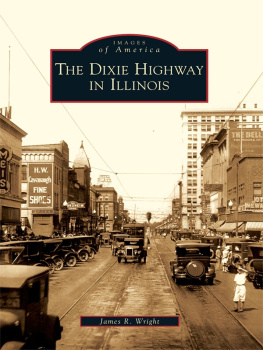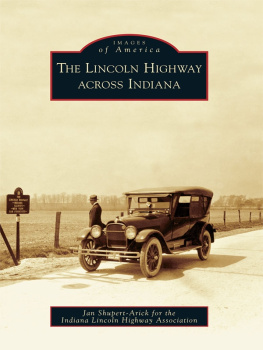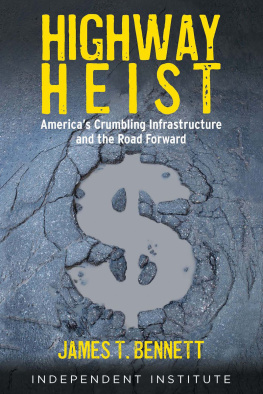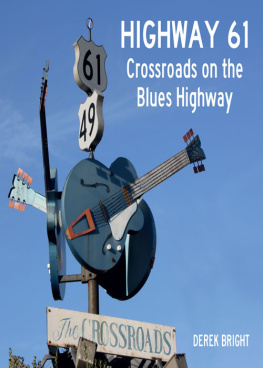Dixie Highway
This book was sponsored by the postdoctoral fellows program at the Center for the Study of the American South, University of North Carolina at Chapel Hill.
2014 The University of North Carolina Press
All rights reserved
Designed and set in Utopia and Gotham types by Rebecca Evans
Manufactured in the United States of America
The paper in this book meets the guidelines for permanence and durability of the Committee on Production Guidelines for Book Longevity of the Council on Library Resources. The University of North Carolina Press has been a member of the Green Press Initiative since 2003.
Library of Congress Cataloging-in-Publication Data
Ingram, Tammy.
Dixie Highway : road building and the making of the modern South, 19001930 / Tammy Ingram.
pages cm
Sponsored by the postdoctoral fellows program at the Center for the Study of the American South, University of North Carolina at Chapel HillTitle page verso.
Includes bibliographical references and index.
ISBN 978-1-4696-1298-0 (cloth : alkaline paper)
1. Dixie HighwayHistory. 2. RoadsSouthern StatesDesign and constructionHistory20th century. 3. RoadsSouthern StatesHistory20th century. 4. TransportationSocial aspectsSouthern StatesHistory20th century. 5. TransportationPolitical aspectsSouthern StatesHistory20th century. 6. Express highwaysPolitical aspectsSouthern StatesHistory20th century. 7. Express highwaysPolitical aspectsUnited StatesHistory20th century. 8. Southern StatesPolitics and government20th century. 9. United StatesPolitics and government19011953. I. University of North Carolina at Chapel Hill. Center for the Study of the American South. II. Title.
TE25.5.D49I64 2014 625.7097509041dc23
2013029961
18 17 16 15 14 5 4 3 2 1
For my mother
and in loving memory of my father
Contents
Figures and Maps
Figures
Ford Model T advertisement from the Athens Herald, November 25, 1916
Carl Graham Fisher, ca. 1915
Two men driving a Buick along the Dixie Highway near Albany, Georgia, 1915
Dalton citizens who traveled to Chattanooga for the routing decision in 1915
Cartoon, Dixie Highway, October 1917
Advertisement, Dixie Highway, April 1917
Hotel advertisements, Dixie Highway, April 1918 and March 1917
Cover of sheet music for Dixie Highway song
Postcard of Dixie Highway from the 1920s
Dixie Highway Association map
DH road marker
Dixie Highway Association membership blank
Cartoon, Dixie Highway, MarchMay 1918
Cover page, Dixie Highway, December 1921
Chain gang working near Monticello, Georgia, early 1900s
Chain gang working on the Dixie Highway in Fitzgerald, Georgia, ca. 1910s
Map of Georgia state highway system, 1920
Lamartine G. Hardman, 1917
John N. Holder
Map of U.S. highway system, designated November 1926
Maps
All the competing routes for the Dixie Highway
The competing routes for the Dixie Highway in Georgia
The Battlefield Route/Johnston-Sherman Highway
The Central and Southern Railroad lines between Atlanta and Macon, Georgia
Acknowledgments
I learned how to drive on the back roads of south Georgia, roads that in the 1980s were not entirely unlike the rutted dirt roads farmers had navigated by horse and wagon a century earlier. Even before I could see over the steering wheel of my dads old one-ton flatbed Ford, I explored the mostly unmarked network of narrow dirt, gravel, and paved county roads around our farm. When farmers passed me in their trucks and tractors, they waved. Once, I encountered the sheriff at a four-way-stop, but he just laughed and wagged his finger. Farmers kids had special privileges in Seminole County, a sparsely populated peanut- and cotton-farming community where long country roads were the lifelines connecting farm families like mine to markets, schools, hospitals, and each other. While this may not explain entirely my decision years later to write about road building in the early twentieth century, I am certain that it helped me to appreciate how important roads were to the people I write about in this book.
My intellectual journey into road building began in graduate school at Yale, when the North Caroliniana Society at UNCChapel Hill granted me an Archie K. Davis Fellowship to begin my dissertation research. Thanks to Harry McKown there for sharing his inexhaustible knowledge of the Good Roads Movement with me and for persuading me that this was a topic worth pursuing. For the next several years, grants and fellowships from the Beinecke Rare Book and Manuscript Library at Yale and the Yale Graduate School supported my research and gave me time to think and write. I am grateful to George Miles and the entire archival staff at the Beinecke for their help, and also to the archivists and librarians at Yales Sterling Memorial Library. Archivists at the National Archives in College Park, Maryland; UNCs Wilson Library; the Chattanooga-Hamilton County Bicentennial Library; the Washington Memorial Library and Middle Georgia Archives; and the University of Georgia Libraries were particularly helpful in the early stages of my research. Follow-up trips to the Tennessee state archives in Nashville; the Russell Library at UGA; the Rome-Floyd Records Center in Rome, Georgia; and the Georgia Department of Archives and History in Atlanta allowed me to complete revisions.
I am indebted to Dawn Hugh and the staff at HistoryMiami (formerly the Historical Museum of South Florida) for assisting me on two research trips to Florida and for giving me access to their wonderful collection of Carl Fisher photos. Jill Severn at the Richard B. Russell Library for Political Research and Studies at UGA helped me with every stage of this project and even tracked down photos for me on her own time. Even after crippling state-budget cuts reduced their staff to just a few, the exceptional archivists at the Georgia Department of Archives and History were generous with their time and assistance. I am especially grateful to Steven Engerrand for his help during my last couple of research trips to Atlanta and for facilitating the process of obtaining permission to use their maps and photos. Gary Doster and Ed Jackson gave me access to their impressive private collections of Dixie Highway photos, two of which appear on the cover of this book. The kind folks at the Whitfield Murray Historical Society in Dalton, Georgia, not only loaned me one of my favorite images in this book but also invited me to give a talk at a particularly critical time during the revision process. Their feedback helped me to rethink the overarching point of this book, and it is all the better for it. I am grateful to them all, but especially to Jennifer Detweiler and to Judy Alderman, a gracious lady and fine historian whose story about the origins of the term peacock alley is a lot better than mine, and no less true.
Im fortunate to have had Chuck Grench at UNC Press as my editor. I am thankful for the time and effort that he, Sara Jo Cohen, Allie Shay, Lucas Church, and especially Jay Mazzocchi put into this book. My thanks as well to Sian Hunter, who supported this project from the very beginning. Above all, Im indebted to my anonymous readers for UNC Press, whose encouragement and constructive criticism helped me to sharpen my arguments and polish my writing.
As I began revising this manuscript, I spent three wonderful years as the Kirk Visiting Assistant Professor of History at Agnes Scott College, where I received substantial support for my research and writing. Thanks to Kathy Kennedy, Mary Cain, Violet Johnson, and Shu-Chin Wu for making me feel so welcome there. A year as a postdoctoral fellow at the Center for the Study of the American South at UNCChapel Hill allowed me to complete the major revisions on this manuscript, and I am grateful to Harry Watson and Sally Greene for making that year such a productive one. Funding from the history department, the dean of the School of Humanities and Social Sciences, and the college-wide research and development committee at the College of Charleston allowed me to finish the book. I thank my colleagues at C of C for their support and encouragement, as well.









